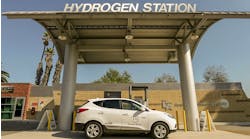In today's classrooms, the three R's might refer to reduce, reuse and recycle. Schools are major consumers and producers of waste, and many are assuming responsibility for instilling environmental values and practices in their students — the next generation of leaders — and serving as role models for their communities.
At universities and K-12 facilities, a tremendous movement is underway to create eco-friendly environments. Facility managers and school administrators are looking for innovative approaches to make a difference — easily, effectively and affordably. Administrators are using environmentally friendly technologies such as resource scheduling applications that deliver environmental benefits and enable education institutions to save money.
Because of increasing interest from students, parents, teachers and surrounding communities, schools and universities are adopting green initiatives. One major effort is the Go Green Initiative, which promotes social responsibility on campuses by minimizing energy consumption and paper usage, and promoting recycling, carpooling and electronic communications. More than 1 million students and teachers in 37 states, as well as Europe and Africa, are participating in Go Green. Harvard University and other colleges are creating their own Green Campus Initiatives to reduce their carbon footprint.
Economics is a key source of motivation in reducing energy consumption. According to a report by APPA, which serves education facilities professionals, “Utility costs make up a significant portion of campus operating budgets, running $1.50 to $2.00 per square foot on average. Most campuses manage millions of square feet, so even incremental savings can have a significant effect on the bottom line. Calls for improved energy resource management arise out of several long-term trends, including financial constraints, competition, student expectations, and accountability.”
Strategic approaches
Some environmentally conscious efforts, such as creating green buildings, can be costly and require a major commitment of time and resources. These programs can be beneficial and save money in the long run, but many institutions don't have the capital to undertake these major projects. But schools and universities can move the green agenda forward with less expensive approaches, such as better use of resources through effective scheduling of shared workspace, resources and assets.
The APPA report identified the critical issues facilities face as resource scarcity and affordability, and recognized that “budgets for universities will remain tight for the near future.” As a result, the group identified two ways to address this issue: “develop strategic management solutions to do more with less” and “develop energy-efficiency strategies that will reduce utility costs and benefit the environment.”
For many schools and campuses, it makes sense to begin with smaller, more manageable eco-friendly initiatives. Following are easy and affordable ways education institutions can move their green initiatives forward:
-
Don't use energy you don't need. Establish an automatic solution for maintaining room temperature. Energy consumption has become a tremendous drain on natural resources. According to the U.S. Department of Energy, Energy Efficiency and Renewable Energy: “HVAC accounts for 40 percent to 60 percent of the energy used in U.S. commercial and residential buildings. This represents an opportunity for energy savings using proven technologies and design concepts.”
Consider the energy waste of heating or cooling rooms that may only be in use sporadically. Universities can use sophisticated resource scheduling technology that integrates with their HVAC systems to automatically adjust the temperature of a room depending on its use. This helps conserve fuel consumption and reduces emissions that typical air conditioning and heating systems emit.
“SUNY Buffalo was able to prove that each degree of overheating or overcooling in campus buildings resulted in $100,000 per year in excess energy use,” according to the APPA report.
-
Track and better utilize resources. By tracking and managing the use of resources and assets, such as audiovisual equipment, schools and universities can use them more efficiently and avoid buying unnecessary items. Similarly, schools can avoid waste by tracking and better utilizing vehicle usage. Rather than using a van or bus to transport one or two people, a school can find a car for the same job. The same concept applies to maintenance. A current practice at some facilities is to change light bulbs and HVAC filters on a regular basis, but by tracking room utilization using an integrated resource scheduling system, facility managers can reduce waste by changing light bulbs and filters only when needed.
-
Reduce paper waste. According to a Worldwatch Institute report, “An average university with a campus population of 10,000 uses more than 1 million sheets of bond and letterhead paper each month.” Facility managers should review manual-based processes within their schools and determine how they might replace them with electronic methods.
Districts and campuses can reduce their impact on the environment by relying on electronic communications more heavily, such as using an automated system or portal to schedule and publicize meetings and share documents. By using technology to reserve rooms and other resources, universities significantly can reduce the paper typically used in manual scheduling books. Additionally, they can integrate scheduling information with electronic displays outside rooms, such as library study rooms, to avoid the need to post paper schedules.
Some school districts and campuses don't just schedule events and meetings electronically, they also publicize them and send out notices using automated systems. Some universities are creating portals and centralized repositories where everyone can access information and search all the activities and meetings within a department. Participants can sign up for notification on changes, as well as reminders.
It is no longer a choice, but a necessity, for schools and universities to undertake environmental initiatives. Administrators have many ways to create a green agenda, and they don't have to be costly or daunting. Finding better ways to use internal resources is a win-win solution for school districts and universities, enabling them to save money and conserve natural resources.
Hamann is vice president, marketing, at PeopleCube, a Framingham-based company specializing in on-demand workplace and resource-management solutions.



